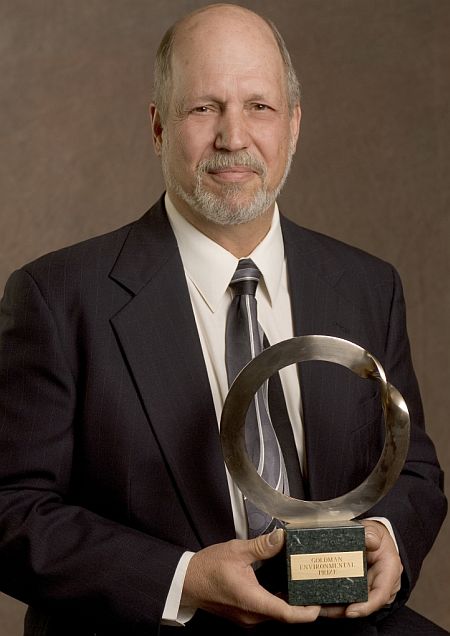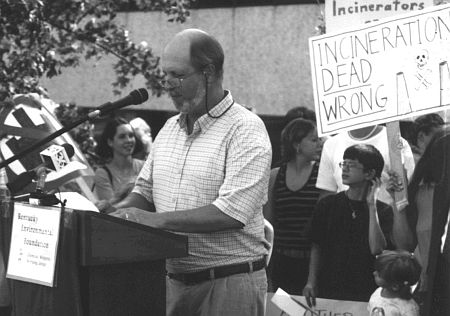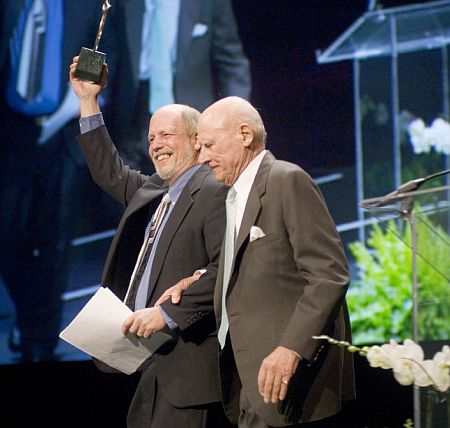
Craig E. Williams, 58, is certainly one of those bravest environmentalists who not only acknowledge the true nature of our planet and penetrate and see easily the bubbling life within it, but have also stood strong to keep it intact.
Craig, a decorated Vietnam War veteran, was awarded The Goldman Environment Prize in 2006 for fighting against government policies and convincing the Pentagon to stop plans to incinerate stockpiles of chemical weapons stored in multiple locations around the United States.
Through this e-mail interview, we’ve tried to through more light on Craig’s movement and the efforts put in to force authorities find better ways to discard around 24,000 tons of obsolete chemical weapons agents in the United States, which are posing serious danger to the living community and environment, with his nationwide grassroots coalition – the Chemical Weapons Working Group (CWWG).
1. What was your first reaction after winning the Goldman Environmental Prize? What does the prize mean to you?
Craig: I was astonished when I got the call from Richard Goldman and his staff. I had no idea I was even being considered. After it sunk in I was quite ecstatic, but was told to keep it secret until April – I got the call in November!
I suppose the most meaningful thing about receiving the prize is the company I now keep with all the recipients – truly amazing people achieving impossible things. Sure, I’ve been doing my work for over two decades, and have had some successes, but when I realize the accomplishments of some of my co-recipients it is truly inspiring. Many are still threatened with physical violence to themselves and their families. Can you imagine the passion and dedication it takes to face the powers that be under these circumstances? Truly, many of these people are hero’s. My being part of this group of folks is most humbling and motivating.
Finally, I sincerely hope that receiving this recognition will provide additional strength and effectiveness in our struggle to protect communities across the country burdened with these WMD’s.
2. Apparently, all pro-incinerators confidently asserted initially that chemical weapons disposal program use safest technologies and do not pose any threat to environment and public health. Keeping aside the fact that “to err is human”, what makes authorities at that high a platform not able to see beyond the fence? Why they fail to take calculated steps and always demand a revolution to act prudently?
Craig: It was puzzling to me at first, after all, using an open-ended technology that depends on “air-in”/”air-out” when dealing with the most lethal chemicals ever made seemed (and seems) irresponsible. Over time I have concluded that there are three main reasons incineration was advocated by the Army and their (well) paid consultants:
a) Lack of liability: When communities are negatively impacted by emissions, either from the CW incinerators or other emissive sources it is up to those afflicted with health problems to prove their illness is a direct result of one specific source, i.e. the chemical weapons incinerator. This is almost impossible to do, and polluters know it – that’s why they like to burn stuff – once it’s out in the atmosphere their liability is significantly reduced. Non-emissive technologies have a direct path back to the specific source (i.e. something spills and contaminates the water, the plume can be tracked back to the source rather easily).
b) Future Use: The military creates more hazardous waste than any other entity in the U.S. Having eight incinerators located around the country to dispose of this material (with little liability!) was seen as a perfect solution. Although the Army will claim no future use intentions, a study done by one of their own contractors in 1991 reflected an astounding list of military toxics for which these incinerators could be used. It is my understanding that discussions are already underway between the Army and the State of Alabama to continue using the CW incinerator there for other toxics. This, in spite of assurances to the contrary AND decades of congressional laws forbidding such use. About 5 years ago, the Army quietly slipped in a change to these prohibitions and the Congress went along. So, communities who have already been chronically exposed to incineration emissions from the burning of chemical weapons can now likely look forward to having other hazardous wastes imported for “disposal” (actually, dispersion).
c) Military mentality: Once the decision was made to incinerate, everyone went running around saluting each other and didn’t question the decision – that’s the way things are done in the military. You carry out your orders – period.
Up until 1970, when it was banned, dumping CW’s in the ocean was considered “state-of-the-art” disposal. In 1982 the Army selected incineration as their next “state-of-the-art” approach, and that is exactly how they presented it to communities which stored these weapons. When asked the most basic of questions regarding safety and environmental protection capabilities they appeared baffled and clearly had no good answers. Over the years, many, if not most of the concerns we raised early on have occurred, for example: there have been 18 releases of chemical agent directly out the smokestack that we can document, we suspect many, many, more; numerous technical malfunctions; agent monitoring malfunctions; astronomical cost increases; enormous schedule slippages; and more.

3. What are the risks involved now when it’s clear that the disposal operations will not be complete until October 2023?
Craig: The first and greatest risk is that of continuing to store these weapons for such an extended period in communities. In Kentucky, for example, we house the most lethal chemicals (VX and GB) in the most dangerous munitions (M-55 Rockets). A worst-case incident from either an external or internal event has the potential to result in over 20,000 fatalities at the Kentucky site. Continuing to have this community live in the shadow of these WMD’s simply because the Pentagon has “other priorities” is irresponsible. It is particularly ludicrous in terms of this Administration’s invasion of Iraq based on the “threat” posed U.S. citizens from Saddam’s WMD’s, that never existed, and their refusal to provide enough funds to get rid of the risks posed by our very own such weapons, that definitely do exist!
4. In the light of present scenario, will it be correct to say that the DOD apparently never had a proper chemical weapons disposal program on the cards?
Craig: I would say that’s pretty close to accurate. Sure, they have demonstrated a commitment of dispose of these weapons, but their approach both from a technology and public involvement standpoint has severely limited their ability to achieve that goal. Interestingly enough, the original proposed completion date for destruction using incineration was presented to Congress in 1986 to be 1994 – that’s complete destruction of the entire U.S. stockpile! We’re now looking at 2023! That’s almost 30 years behind schedule – amazing, even for government work. The cost escalation is also. In 1986 the price tag for complete disposal was $1.85 Billion. It’s now publicly said to be at $32 Billion, but internal sources peg it at closer to $40 Billion.
5. What CWWG is doing to speed up the process and how far do you think you and the movement would be able to succeed in doing that?
Craig: We are advocating many modifications to the current path being taken by the Army. We strongly recommend that all the Mustard agents remaining at incineration sites be neutralized due to unexpected high concentrations of Mercury therein and extreme solidification of the agents in weapons/containers. Mercury can not be destroyed by heat and is a serious pollution problem across the U.S. – releasing more is not advised nor necessary. Solidification of Mustard posed significant operational challenges that the incinerators were not designed to handle causing elongated processing times, higher toxic emissions and increased costs.
We are also advocating on-site treatment of all processing by-products as a means of insuring Treaty compliance while avoiding controversy, opposition from targeted reception communities and potential litigation, all of which adds time and costs to the overall objective.
In addition, we believe less than adequate funding for the program is “penny-wise /pound-foolish” in regards to diligent use of tax-payer dollars — but more importantly, increases the risks associated with maintaining the stockpile in storage. An example of bad fiscal judgement is Kentucky and Colorado where the Pentagon has decided to request less funding per year for these sites’ disposal program, stretching out the schedule, but also adding over $3 Billion to the cost of the combined projects. So, with full funding both sites could be done by 2016 for around $4 Billion. But, but pinching pennies on an annual basis it will take 7 years longer and cost $7 Billion! There is not reason for such waste and risk.
6. What best disposal strategy would you suggest from the perspective of the nation as a whole?
Craig: Much of what we recommend is captured in the above question. One additional element that requires a complete overhaul is the Army’s persistent exclusion of meaningful citizen involvement. With the exception of the CO and KY sites, managed by the Pentagon, not the Army, there is a growing trend of providing less and less real involvement and information to the public on matters associated with the disposal program.
A recent example would be the covert approach the Army has used to contract the disposal of the Indiana VX agent by-product, know as hydrolysate. After two unsuccessful attempts to ship this material off-site (first to Ohio, then to New Jersey) the Army secretly contracted with an incineration company in Texas to burn this material. No one at the community level was informed ahead of time and no information provided, much less an attempt at an agreement between the community and the Army to accept the material. Now, communities are up in arms, litigation is poised to begin and a political firestorm is brewing. This underhanded method of dealing with the public is counterproductive and will only lead to increased risks, costs and extended schedules.

7. What about the chemical weapons disposal scenario in other countries, are they able to meet the targets?
Craig: Some have, some will and some won’t depending on a number of variables. Many of the signatories didn’t have CW’s to begin with, their obligations being not to procure, develop or trade in such weapons under the Treaty. Other countries who did possess small quantities, such as Canada, have completed their disposal years ago and are thus in compliance. Albania, a recent signatory country, is expected to miss the 2007 deadline by a mere few months. England just recently declared their stockpiles destroyed. However, the two major possessors, the U.S. (30,000 Tons) and Russia (40,000 tons) are woefully behind even the extended deadline of 2012. The Russian Federation has achieved about 20% disposal and the U.S. about 40% as of 1 April 2007.
8. It’s been a long journey for you. What hurdles you faced and what exactly drives the environmentalist is you to go on and on despite all the hardships you face during your movement?
Craig: Initially it was the fact that these WMD’s were just up the road and no one knew about them. Of course, the Army’s announcement that they intended to burn them caught my attention. There has never been anyone I’ve asked, “What do you think of burning the most lethal chemicals on the planet in the middle of a populated area?” that hasn’t remarked they’re feeling of astonishment at the idea….except the Army, of course.
Try flouting this idea in some well-to-do section of the country and see how far you get…say, Nassau County Long Island or Palm Springs, CA. forget it! But most of the stockpiles are in areas of lower to middle class small cities/towns with little political clout and thus a difficult paradigm from which to exert pressure on a bureaucracy as large as the Pentagon.
Regardless, I felt compelled to push back and although the stress on family and friends, along with myself, was often challenging, persevered due to my belief in the rights of citizens to have a meaningful say in matters that would directly impact their health and their environment.
From this very local level of interest and engagement began the building of the Chemical Weapons Working Group coalition I now direct. Not surprisingly, there were citizens and organizations at all the sites that shared our concerns here at home. They also felt strongly that, left to their own devises, the military would not consider what’s best for their community.
Developing consensus within such a diverse group of folks has not always been easy, but for 17 years now we’ve managed to form a united front on our objectives and strategies based on common values of respect, consideration and cooperation.
9. Does Vietnam still haunt you? How your stay over their changed your perception of life?
Craig: I wouldn’t say “haunt”. Rather I would admit that it is an experience that will never be forgotten and changed my life – in my opinion, for the better. It is one of those contradictions in life where the worst thing you go through turns out to be the most beneficial in the long term. The experience for me was one which revealed the serious errors that can be made when decisions are not considered on all levels – similar to the situation in Iraq today. Leaders often forget that they are prone to mistakes, just like anyone else, as the power they wield obscures the ramifications of their decisions.
Vietnam also opened my eyes to what people, common people, can do if they dedicate themselves to a cause. If, in 1962 anyone would have proposed that a basically peasant agrarian Third World country would have the capability to defeat a Super Power they would have been called crazy. But, that’s what happened – it was inspiring and a testimonial to the will of the people to overcome huge obstacles if they are willing to dedicate themselves to their beliefs.
10. Where you would like to take your fight, are there any set goals?
Craig: The chemical weapons issue is one of finite duration. Sooner or later it will be finished and, thankfully, an entire class of WMD’s will be rid of. This is a tremendous step towards a safer world and hopefully sets the stage for future disarmament achievements.
Our goals for now include the abandonment of incineration for the Mustard stocks remaining in the U.S.; the ceasing of shipments of agent by-products across our highways; a curtailment of dumping these by-products on poor and minority communities; the deployment of advanced agent monitoring systems to replace the 30+ year old technology currently being used; a much higher level of accountability by the government regarding their operations; greater transparency within the program; meaningful citizen involvement – not announcements; and, ultimately the “safe” and “protective” disposal of these hideous weapons of mass destruction globally.

